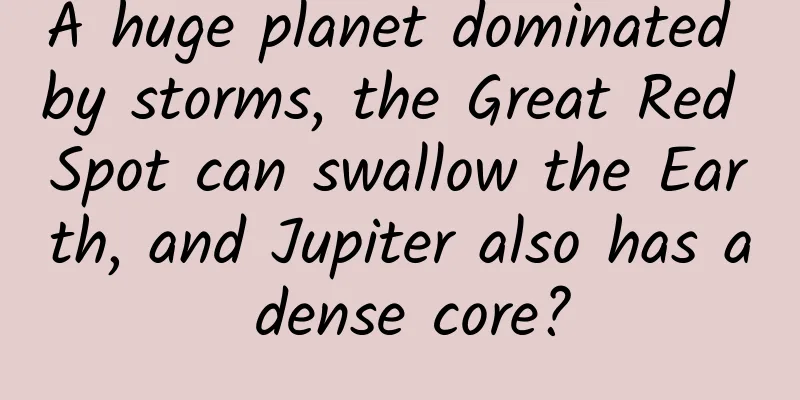A huge planet dominated by storms, the Great Red Spot can swallow the Earth, and Jupiter also has a dense core?

|
Jupiter, one of the eight planets in the solar system, is known as the "king of planets". In ancient times, my country called it Suixing and Taisui. "How dare you touch the head of Taisui!" This familiar proverb is enough to reflect the power of Jupiter. With the exploration of modern science and technology, Jupiter has shown its kingly temperament to the fullest. The mass of Jupiter is about 1.9×10∧27 kilograms. What does this mean? It is 318 times the mass of the earth. Even if the other seven planets are tied together, the mass of Jupiter is still more than 2.5 times their total. In terms of volume, Jupiter's body is terrifying, with an average diameter of about 140,000 kilometers. Jupiter is not a perfect sphere. Its equatorial diameter is longer than its polar diameter, and it looks a bit flat. If the entire Jupiter is hollowed out, more than 1,300 Earths can be stuffed in. Jupiter is the fifth planet from the inner to the outer solar system. It is about 779 million kilometers away from the sun, and its surface temperature is as low as -108°C. It is much larger than the four terrestrial planets with rocky surfaces: Mercury, Venus, Earth, and Mars. The "fat" Jupiter is a gas giant planet, mainly composed of hydrogen and helium, with very small amounts of methane, ammonia, water, etc. If astronauts want to land on Jupiter, they will find that there is no place to "step". They will fall into the terrifying atmosphere of Jupiter and will be crushed to pieces in a moment. Jupiter's atmosphere is more than 5,000 kilometers, with 20 Earth atmospheres. The deeper you go, the greater the pressure. On December 7, 1995, the Galileo Jupiter atmospheric probe was fully protected and rushed into Jupiter's atmosphere at a speed of 50 kilometers per second. The scientific instruments it carried raced against time to carry out detection, but it lost contact with the mother ship after only 57 minutes. This "warrior" will eventually merge with Jupiter under high temperature and high pressure. It takes about 12 years for Jupiter to orbit the sun, which the ancients called "one era". Jupiter's rotation speed is the fastest among the eight planets, and it takes only about 10 hours to rotate once. The high-speed rotation drives the atmosphere on the surface of Jupiter to move violently. From the photos of Jupiter, we can see that the atmosphere on its surface is divided into different belts according to latitude, and huge storms and turbulence will form at the intersection of each other. Indeed, at first glance, Jupiter has a beautiful appearance like a rain flower stone. However, when we go deeper into the beautiful stripes, we will feel the horror of suffocation. Jupiter (beautiful stripes) is constantly blasted with huge storms, and lightning is in the storms. Storms at the North and South Poles are the mildest, at about 150 meters per second. You should know that in 2005, Hurricane Katrina, a Category 5 hurricane that killed nearly 1,900 people in the United States and almost razed the entire city of New Orleans to the ground, had an average wind speed of only about 77 meters per second at its center. The strongest wind speed on Jupiter can reach 1 kilometer per second, and the speed of sound is only 340 meters per second. How can we not mention the famous "Great Red Spot" when talking about Jupiter, the stormy planet? It is not only the largest anticyclonic storm on Jupiter, but also the largest anticyclonic storm in the solar system. The Great Red Spot is about 25,000 kilometers long and 12,000 kilometers wide. The airflow contains a large amount of red phosphorus compounds. It is located in the southern equatorial belt of Jupiter and rotates once every 6 Earth days. As early as 1664, British naturalist Robert Hooke discovered this special spot on Jupiter. In 1979, the Voyager 1 probe observed the Great Red Spot up close for the first time. The complex and ever-changing clouds are like rolling waves, gathering into a vortex leading to the abyss. Many astronomy enthusiasts call the Great Red Spot the Eye of Jupiter. This huge pupil looks coldly at the Earth, which makes people with "Jupiter phobia" feel a chill down their spines. Studies have shown that in the 17th century, the Great Red Spot could fit at least three Earths. Over the past few hundred years, the Great Red Spot has been shrinking, and some scientists even say it may disappear in the next half century. Today, the Great Red Spot is still more than enough to fit one Earth. Imagine a small ball placed in a huge wind tunnel, being blown left and right, and a mess... If we think that Jupiter is all "empty" gas, we are wrong. In recent years, the academic community generally believes that Jupiter has a rocky core composed of iron and silicon. This core was formed when the original nebula of the solar system was formed. The volume of Jupiter's core is about twice that of the Earth, and its mass is about equivalent to 12 Earths. Enveloping this core is liquid metallic hydrogen formed under the terrifying pressure of Jupiter. What? Hydrogen can become liquid metal in Jupiter? We’ll talk next time. (Please obtain authorization for reprinting, otherwise legal action will be taken; the pictures in this article are from the Internet, thanks to the original author, if there is any infringement, please contact to delete) |
Recommend
Short video traffic matrix creation, SEO + two-cut fission, the effect is super good!
Short video traffic matrix creation, SEO + two-cu...
National meeting to stabilize the economy is held! What time will it be held? What is the main content?
Recently, the State Council held a meeting to fur...
In these three information flow cases, how can the customer acquisition cost be controlled within 60?
Today I bring you several excellent information f...
Android Developer: Why I Switched to Kotlin
A word of caution, as a person who doesn't st...
Could this bowl be a "death bowl"? I didn't expect it to be so harmful! Throw away any bowls at home
Expert of this article: Yang Chao, PhD in Chemist...
Driving sharing model: the secret to getting users to actively share traffic
Since the Internet traffic dividend began to grad...
Eight crooked tricks for APP promotion! Have you ever used these tricks?
Nowadays, the popularity of APP is almost as high...
Why do Chinese people like to use it to stew meat, but foreigners like to use it to make drinks?
When the weather gets cold, we can't help but...
The traffic operation logic of Taobao, Douyin and Kuaishou!
In the traditional centralized e-commerce model, ...
Memory leak troubleshooting from entry to mastery
The most primitive memory leak test Repeat the op...
How to make a 1 million dollar budget advertisement look like 10 million dollars?
George Lewis: Great advertising can make a millio...
Searching for “MOSS” in the real world (Part 3): The “first front” in the quantum computing race
Produced by: Science Popularization China Author:...
How to place a good advertisement? How to acquire customers at low cost?
1 The purpose of advertising is either branding o...
Overseas Promotion丨How to get millions of views on TikTok?
TikTok Ads Performance Advertising Optimization T...
Is the new coronavirus caused by the Omicron variant equivalent to a large-scale flu?
Is the new coronavirus caused by the Omicron vari...









